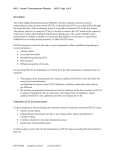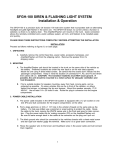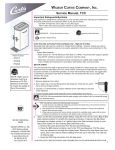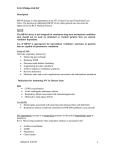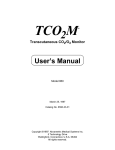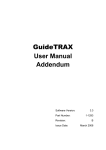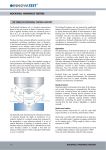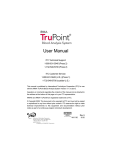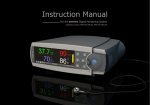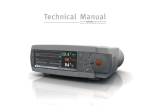Download Radiometer - Wiki@UCSF
Transcript
603 Radiometer (TINA) / HP Merlin tcPO2/CO2 Monitor 603/ Page 1 of 6 Description The Radiometer transcutaneous O2/CO2 monitor system (TINA) has three basic parts. The TCC3 regulates the calibration gas using a single cylinder of dry gas for calibration purposes. The TCM3 is the main processing and display unit. The third part is the combined tcPO2/pCO2 electrode that combines a heating element, two temperature sensors, a Clark-type oxygen electrode and a Severinghaus-type carbon dioxide electrode in a single unit. The TINA allows for continuous non-invasive monitoring of the patient's O2 and CO2 status and has the capability of recording the data for trend observation. The monitor contains nickel-cadmium (NI-CD) rechargeable battery and can be used as transport unit. The battery will last 3 hours when fully charged. Hewlett-Packard monitors in the 6H Infant Care Center incorporate the Radiometer system into a Merlin plug in module. Use and operation of the HP Merlin module TCM is identical to the Radiometer system. The primary objective in using the TCM is to be able to observe the PO2 and CO2 trends of the patient by noninvasive means rather than drawing numerous blood gases. This system should be used preferentially on infants, children, or any patient that might be at risk from too much blood withdrawal or too many arterial punctures, or whose PaO2 or PaCO2 values are labile. When using an auxiliary heat deviation mode the practitioner can monitor the change in mW required to heat the electrode to arterialize a particular area. This information alerts the therapist of a change of perfusion in the immediate area and possibly a change in the patient's overall hemodynamic status. Alarms built into the system will alert the practitioner to tcPO 2 and tcPCO2 values exceeding the limits that have been set. Also, there are alarms to indicate electrode fault, low battery, and excess temperature deviation. Physician's Orders A physician must order Transcutaneous Monitoring. The unit should be used in 6H ICN or 4E ICU. The unit is not to be used on 6A unless approved by the Respiratory Therapy supervisor (and that should occur only in the most unusual of circumstances). Equipment Needed The TINA TCM or HP Merlin Module system Disposable fixation rings Alcohol swab and 4 X 4 Contact liquid Calibration gas cylinder SFGH RCS Reviewed: 8/92, 5/94, 3/02, 7/04, 10/07, 11/10, 6/11 Revised: 2/88, 3/99, 10/07, 09/08, 3/13 603 Radiometer (TINA) / HP Merlin tcPO2/CO2 Monitor 603/ Page 2 of 6 Remembraning kit o O-ring remover o Cleaning paper o Electrolyte solution o Membrane unit User Manual Procedure Pre-Calibration Note: monitor should be plugged in and power on at all times to keep the monitors charged. 1. Turn on the power. 2. Calibrate the monitor. A calibration is necessary when the monitor is first turned on, when the electrode has been remembraned, and whenever tension readings are unstable and do not correlate with the blood gas values. A calibration should be done with every site change. Calibration 1. Completely open the electrode socket door and carefully place the electrode in the socket located on the face of the TINA. Extreme caution is to be taken to assure the electrode membrane is not scratched when placing the electrode in and out of the socket. When the electrode retainer is carefully swung into position over the electrode, the CAL lamp will flash indicating that the unit is ready to calibrate. 2. Connect the nylon tube from the pipe stub on the calibrating unit to the pipe stub on the monitor. 3. Press the -> button on the calibration unit. The green lamp will flash to indicate that gas is flowing. 4. Push the CAL button. During calibration the CAL and °C lamps will light continuously. Measured temperature and pO2 and pCO2 values will appear on the displays. 5. After 3-10 minutes, the READY lamp will light up. The displayed values should correspond to the calibration gas (159, 40). If there is a match, the system is calibrated and ready for use. If there is no match, someone may have inadvertently changed the internal calibration values or the electrode is faulty. SFGH RCS Reviewed: 8/92, 5/94, 3/02, 7/04, 10/07, 11/10, 6/11 Revised: 2/88, 3/99, 10/07, 09/08, 3/13 603 Radiometer (TINA) / HP Merlin tcPO2/CO2 Monitor 603/ Page 3 of 6 6. Press the "->" button on the TCC calibration unit to shut off the gas, otherwise it will automatically shut off after 20 minutes. Note: Remove the electrode from the electrode socket within 30 minutes of calibration or else it will be necessary to repeat the calibrations before placing the electrode on the patient. Before Application to Patient 1. Inform the nurse assigned to the patient that: a. The electrode and the cable combine to form a sensitive and fragile piece of equipment. b. The pCO2 portion of the electrode should not be left dangling or allowed to drop on the floor. c. Stress or tension should not be applied to the cable. d. Replacement cost of electrode is $1,500.00. 2. Insure that all hospital personnel likely to handle the electrode are provided the above information. Continuous ongoing inservice is of the utmost importance. Application to Patient/Site Change Caution: Do not clean electrode membrane with alcohol or other liquids. Do not wipe membrane as this might loosen membrane from the O-ring. Enter all values by pushing the SET button. 1. Set the electrode temperature between 42 and 44 degrees C for neonates. 2. Choose an appropriate measuring site on the patient; for neonates - the chest and abdomen. 3. Clean the site with alcohol. 4. Remove the protective lining from the fixation ring and place the ring on the measuring site. 5. Place 3 to 5 drops of the contact liquid on the skin through the hole of the fixation ring. 6. Align the arrow on the electrode with the large mark on the fixation ring and twist 1/4 turn clockwise to lock in place. SFGH RCS Reviewed: 8/92, 5/94, 3/02, 7/04, 10/07, 11/10, 6/11 Revised: 2/88, 3/99, 10/07, 09/08, 3/13 603 Radiometer (TINA) / HP Merlin tcPO2/CO2 Monitor 603/ Page 4 of 6 7. The tcPO2 values should stabilize in approximately 10-15 minutes and the tcPCO2 values in 3-7 minutes. 8. After stabilization of values, set the high and low alarm limits and the site timer (to alert when a site change is required). 9. Change the site location every three to four hours. Patient’s <1000grams, change site every 2 hours, increasing to every 4 hours if skin tolerates. If a red mark still remains after 2 hours, either decrease the temperature or change the site more frequently. Changing Membrane When the TCM is being used nearly every day the electrolyte solution will gradually dehydrate and the membrane will shrivel. This is caused by the constant exposure to the heated electrode. Therefore, if the TCM is in frequent use, remembrane the electrode every two weeks to insure reliable values are being produced. Chart membrane changes on the cardiopulmonary flowsheet. 1. Remove the old O-rings and membranes by placing the O-ring Remover opposite to the electrode cable, just above the arrow, and turning it clockwise. The O-rings will now slip off, and the two membranes can be peeled off. 2. Carefully wipe the electrode tip with tissue paper. a. DO NOT polish the electrode face. b. DO NOT clean the electrode face with alcohol or other liquids. c. DO NOT dirty the electrode face with your fingers. 3. Apply 2 drops of the combined tcPO2/PCO2 Electrolyte Solution to the cleaned surface. Make sure that the electrolyte covers the entire surface without any air bubbles. 4. After 30 seconds, blot away solution and reapply 2 drops. This will remove any film that may have developed. 5. Insert the electrode into the top of the green tcPO 2/PCO2 membrane unit and gently press down on the back of the electrode until a "click" is heard. 6. Remove the electrode from the Membrane Unit and gently wipe off the surplus electrolyte with a soft tissue. This is important because excess solution may drip into TINA when the electrode is inserted into the calibration chamber. The electrode is now ready for calibration. Patient Assessment / Reassessment The patient’s response to procedures should be assessed and reassessed. Patient assessment and reassessment should be performed according to the general RCS policy (see Section IV - Patient Assessment / Reassessment in the RCS Policy Manual). SFGH RCS Reviewed: 8/92, 5/94, 3/02, 7/04, 10/07, 11/10, 6/11 Revised: 2/88, 3/99, 10/07, 09/08, 3/13 603 Radiometer (TINA) / HP Merlin tcPO2/CO2 Monitor 603/ Page 5 of 6 Specific criteria for assessment and reassessment should include: Development of the following complications Complications Skin burns--The TCM causes arterialization of an area by means of hyperthermia. Therefore, there is always the risk of skin burns. This risk can be minimized by changing the measuring site every 2 to 4 hours and by using the appropriate temperature for the patient, i.e. 43° or 43.5° for infants. Particular attention should be given those patients who are in shock, have low blood pressure, or have vascular constriction. Areas which have compromised perfusion will burn more easily since the cooling effect of the blood will be inadequate. Poor correlation with ABG values--There are many possible reasons for poor correlation values, all of which need to be investigated. o An error in calibration of the electrode e.g. wrong calibration values entered into internal memory, will result in poor correlation with ABG values. Be sure the electrode is calibrated correctly. o An air bubble between the membrane and the electrode will adversely affect the tcPO2 values. Therefore, always calibrate after remembraning the electrode. Do not confuse the large air bubble inside the CO2 glass electrode with an air bubble between the membrane and PO2 electrode. o If the tcPO2 values drift constantly and do not correlate with the ABG's there may be an air bubble between the membrane and the patient's skin. In this case, detach the electrode from the fixation ring, make sure there is enough contact liquid and that there are no bubbles in it, and reattach the electrode. o A change in the patient's hemodynamic status can be reflected in the TCM measurements. If there is inadequate vasodilation at the measuring site, secondary to shock or hypotension, the tension readings will not stabilize and will not correlate with the ABG's. Be aware, however, that the readings may be accurate for that immediate area and that this may be the first indication that the patient is going into shock. o When the TCM is being used nearly every day, the electrolyte solution will gradually dehydrate and the membrane will shrivel. This is caused by the constant exposure to the heated electrode. Therefore, if the TCM is in frequent use, remembrane the electrode every two weeks to ensure reliable values are being produced. Log all membrane changes. Electrode cable--The electrodes and the cable combine to form a sensitive and fragile piece of equipment. The tcPCO2 electrode should not be left dangling or allowed to drop on the floor. Stress or tension should not be applied to the cable. SFGH RCS Reviewed: 8/92, 5/94, 3/02, 7/04, 10/07, 11/10, 6/11 Revised: 2/88, 3/99, 10/07, 09/08, 3/13 603 Radiometer (TINA) / HP Merlin tcPO2/CO2 Monitor 603/ Page 6 of 6 Other Therapists should be aware that there is a "correction factor" feature in the Main Menu. It allows the transcutaneous values to be "fudged" into line with arterial values obtained from an arterial blood gas. There is no recommendation either way as to when or whether it should be used. Just be aware that it is there. House Formula Select an appropriate electrode temperature for the patient, i.e. 43° or 43.5° for infants. Calibrate monitor. Choose a suitable measuring site. Change the measuring site every 2 to 4 hours. Discontinuation Wipe everything down with germicidal wipes including the plastic part of the electrode and the cable. Do not clean the electrode face with alcohol or any other solution. Do not remove the membrane during this cleaning procedure. However, after having used the electrode on an isolation patient it is advisable to change out the membrane. The electrode costs $1500.00. Be very, very, very careful! Charting Chart transcutaneous values with each ventilator check or every three hours if the patient is not being ventilated on the patient’s Cardiopulmonary Flowsheet. SFGH RCS Reviewed: 8/92, 5/94, 3/02, 7/04, 10/07, 11/10, 6/11 Revised: 2/88, 3/99, 10/07, 09/08, 3/13






